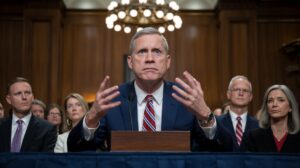Iran Seeks Indirect Talks with U.S. as War Tensions Explode — Regional Nations Warned of “Severe Consequences” — a headline that captures a turning point in rising global tensions and the urgent diplomatic efforts now shaping U.S. foreign policy across the Middle East.
What Does Iran Really Want from Indirect Talks?
Iran has chosen to pursue indirect nuclear negotiations with the United States through Omani mediation. Why not talk directly? Tehran distrusts Washington’s motives, especially following years of economic sanctions and threats of military strikes.
Instead of face-to-face dialogue, Iran sees indirect talks as a way to test America’s sincerity—without appearing weak to internal hardliners or external adversaries.
Iran’s Diplomatic Strategy
Iran's Diplomatic Strategy
│
├── Rejects Direct Talks
│ ├── Distrust of U.S.
│ ├── Political Optics
│
├── Accepts Indirect Talks
│ ├── Via Oman
│ ├── Controlled Narrative
│ └── Risk Mitigation
│
└── Objectives
├── Sanctions Relief
├── Avoid Military Conflict
└── Maintain Nuclear LeverageWhy Iran Is Warning U.S.-Backed Regional Allies
In a bold and direct statement, Iran warned Gulf Cooperation Council (GCC) nations such as Kuwait, UAE, Bahrain, Qatar, Iraq, and Turkey not to participate in any U.S.-led strikes from their soil or airspace.
Tehran declared that any such cooperation would be considered a “hostile act”—one that could provoke retaliation and drag the region into direct conflict.
There are over 45,000 U.S. military personnel stationed across the Middle East, including 13,000 in Kuwait and 5,000 in Qatar, according to the U.S. Department of Defense.
This makes the stakes even higher for countries caught in the middle of U.S.-Iran tensions.
The Real Reason Behind This Escalation in 2025
Iran is enriching uranium to 60% purity, just shy of the 90% threshold required for nuclear weapons. While Iran claims peaceful intentions, the international community—especially Israel and the U.S.—remain skeptical.
Iran’s military alert status, alongside increased U.S. troop deployments and Israeli saber-rattling, make this moment dangerously fragile.
Did You Know? Israel reportedly conducted 3 major cyberattacks on Iranian nuclear sites in the past 18 months, increasing Tehran’s fears of further Israeli action.
What This Means for America’s Foreign Policy
The Biden administration faces a strategic dilemma. Pursuing diplomacy is necessary—but complex. Failing to act could embolden Iran, while acting too aggressively could alienate key Arab allies.
Iran’s two-month window for talks adds urgency. The U.S. must now decide: negotiate smartly or prepare for a broader regional conflict that could cost lives, credibility, and billions.
Conclusion: What’s Next, and Why It Matters to Americans
This story is more than a Middle Eastern issue—it’s an American foreign policy emergency that could shape the 2024–2025 geopolitical landscape. Iran’s push for indirect talks is a calculated power move, and its regional threats are not bluffs.
For U.S. readers, this isn’t just news—it’s a warning: The next phase of diplomacy or conflict will directly impact gas prices, defense budgets, and international stability.
Subscribe to trusted news sites like USnewsSphere.com for continuous updates on global diplomacy, military tensions, and U.S. foreign policy.
[USnewsSphere.com / reu]





